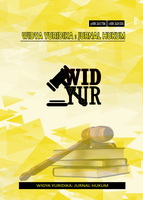Voluntary Restraint Sebagai Hukum Untuk Membatasi Penggunaan Hak Veto Negara dalam Kasus Penyelesaian Mass Atrocity
DOI:
https://doi.org/10.31328/wy.v8i1.5798Keywords:
Mass Atrocity, United Nations Security Council, Veto Rights; Voluntary RestraintAbstract
This research objective is to analyze Voluntary Restraint as a legal concept to limiting the veto used by P5 countries of United Nation Security Council (5 permanent member of UNSC) in settlement of mass atrocity case. This research is a normative juridical research that used conceptual and historical approach. Veto is used by P5 countries only for their benefits and national interest, even in cases that are clearly a serious violation of principles in UN and International community, and because of that the used of veto must be limited. Voluntary Restraint is a legal concept that essentially limits or prohibits the veto use, especially in mass atrocity cases and this is in line with Jus Cogens principle, which is the peremptory norm that has been agreed by the international community including by the P5 countries. The findings of this research are that Voluntary Restraint is a Law itself and as a manifestation of the Jus Cogens principle. Ideally this concept should be a written norm in the UN charter, but this concept can be implemented or not is back to the commitment about world peace, international security and respect of Human Rights from the P5 countries itself.References
DAFTAR PUSTAKA
Buku :
Hiariej, Eddy O.S. (2010). Pengadilan Atas Beberapa Kejahatan Ham. Jakarta: Erlangga
Hiariej, Eddy O.S. (2009). Pengantar Hukum Pidana Internasional. Jakarta: Erlangga
Mahmud, Peter. (2005). Penelitian Hukum Edisi Revisi. Jakarta: Prendamedia Group.
Muhaimin. (2020). Metode Penelitian Hukum. Mataram: Mataram University Press
Rudy, Teuku May. (2011). Hukum Internasional 2. Bandung: Refika Aditama
Slamet, Titon. (2009). Pengantar Sistem Hukum Indonesia. Bandung: PT Alumni.
Trahan, Jennifer. (2020). Initiatives to Voluntarily Restrain Veto Use in the Face of Atrocity Crimes, Dalam Trahan, Existing Legal Limits to Security Council to Veto Power in the face of Atrocity Crimes. Cambridge: Cambridge University Press.
UN Secretary General’s High-Level Panel on Threats, Challenges and Change. (2004) A More Secure World: Report of the High-level Panel on Threats and Change. New York: UN Departments of Public Information.
United Nations. (2014). Framework of Analysis for Atrocity Crimes: a tool for prevention.†New York: United Nations Office on Genocide Prevention and the Responsibility to Protect.
Wouters, Jan and Tom Ruys. (2005). Security Council Reform: A New Veto for A New Century?. Brussels: Academia Press IRRI-KIIB.
Jurnal :
Adediran, Bolarinwa. (2008). Reforming the Security Council through a Code of Conduct: A Sisyphean Task?. Ethics & International Affairs 32(4) 463–482.
Chigora, Percyslage and Dorothy Goredema. (2010). Zimbabwe-Russia Relations in the 21st Century. Alternatives: Turkish Journal of International Relations 9(4), 187-204.
Junaidi, Ahmad. (2014). Tinjauan Yuridis Atas Upaya Reformasi Dewan Keamanan Perserikatan Bangsa-Bangsa Dalam Menciptakan Tatanan Negara-Negara Di Dunia Yang Berdaulat, Damai, dan Adil. Journal of International Law Universitas Sumatera Utara.
Khalfaoui, Anna. (2020). Mass Atrocities: Definition and Relationship with Development, Peace, Justice and Strong Institutions. Springer Encyclopedia of the UN Sustainable Development Goals.
Madhuri, Mutari dan Najar Pratama. (2017). Kontradiksi Penggunaan Hak Veto Atas Kesetaraan Prinsip Kedaulatan Anggota PBB. Doktrin: Jurnal Dunia Ilmu Hukum dan Politik: vol 2(2), 309-316.
Papalia, Giorgia. (2017). A critique of the unqualified veto power.â€Perth International Law Journal vol 2, 55–63.
Pérez, Juan Pablo and León-Acevedo. (2023). Compensation in Cases of Mass Atrocities at the International Court of Justice and the International Criminal Court. The Law & Practice of International Courts and Tribunals 22, 30-61.
Putri, Sabrina Nusastuti Sudirman dan Yessi Olivia. (2014). Kebijakan Rusia Mengeluarkan Hak Veto Terhadap Rancangan Resolusi Dewan Keamanan Pbb Tentang Konflik Sipil Di Suriah. Jurnal Online Mahasiswa Fakultas Ilmu Sosial Dan Ilmu Politik 1(1).
Samekto, FX.Adji. (2019). Menelusuri Akar Pemikiran Hans Kelsen Tentang Stufenbeautheorie Dalam Pendekatan Normatif-Filosofis. Jurnal Hukum Progresif, 7(1), 1-19. Doi:https://doi.org/10.14710/hp.7.1.1-19
Sulbianti, I Made Pasek Diantha dan Made Mahartayasa. (2016). Hak Veto Dewan Keamanan Perserikatan Bangsa-Bangsa dalam Kaitan Dengan Prinsip Persamaan Kedaulatan. Kertha Negara: Journal Ilmu Hukum 4(3).
Trahan, Jennifer. “Legal Issues Surrounding Veto Use and Aggression. (2023). Case Western Reserve Journal of International Law 55(1).
Trahan, Jennifer. (2020). Questioning Unlimited Veto Use In The Face Of Atrocity Crimes. Case Western Reserve Journal of International Law 52(1/2), 81.
Yiu, Hannah. (2009). Jus Cogens, The Veto and The Responsibility to Protect: A New Perspective. The New Zealand Yearbook of International Law 7, 207-53.
Website :
Merriam-Webster.com Dictionary, s.v. “voluntary.†https://www.merriam-webster.com/dictionary/voluntary.Merriam Webster, “law dictionaryâ€,
Merriam-Webster.com Dictionary, s.v. “restraint.†https://www.merriam-webster.com/dictionary/restraint
UNA-UK. 2015. UN Security Council and the responsibility to protect: Voluntary restraint of the veto in situations of mass atrocity. Diambil 24 April 2024, dari https://una.org.uk/sites/default/files/Veto%20R2P%20code%20of%20conduct%20briefing%20October%202015%20update_0.pdf.
Downloads
Published
How to Cite
Issue
Section
License
Copyright (c) 2025 Chris Emilians Jacobus, Freidelino de Sousa

This work is licensed under a Creative Commons Attribution-ShareAlike 4.0 International License.
AttributionYou must give appropriate credit, provide a link to the license, and indicate if changes were made. You may do so in any reasonable manner, but not in any way that suggests the licensor endorses you or your use.
ShareAlike If you remix, transform, or build upon the material, you must distribute your contributions under the same license as the original.
Widya Yuridika: Jurnal Hukum allows readers to read, download, copy, distribute, print, search, or link to its articles' full texts and allows readers to use them for any other lawful purpose. The journal allows the author(s) to hold the copyright without restrictions. Finally, the journal allows the author(s) to retain publishing rights without restrictions
- Authors are allowed to archive their submitted article in an open access repository
- Authors are allowed to archive the final published article in an open access repository with an acknowledgment of its initial publication in this journal
========================================
Editor-in-Chief
Widya Yuridika: Journal of Law.
Faculty of Law, Universitas Widya Gama, Malang, Indonesia.

















